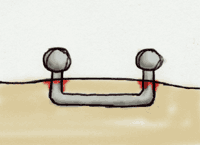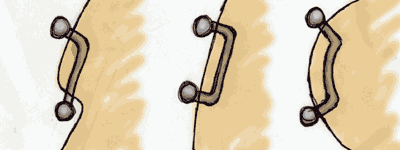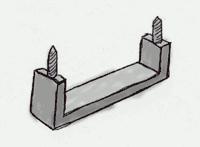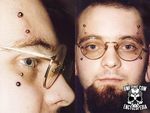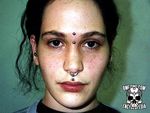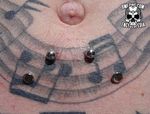Surface Bar
While Surface Piercing is a diverse art, and different piercings do need different solutions, if a generalization is to be made, is it generally agreed upon that surface bars are the best available solution to the surface piercing problem.
Contents |
Definition
First, a surface bar is made of a rigid material, generally titanium or stainless steel. Second, a surface bar is never larger in gauge that required, nor is it longer than required — it leaves a minimal footprint.
Finally, its shape must be matched to the anatomy (which means that you probably will need a consultation first, and then an appointment for the piercing a week or two later). First, the bars should only extend enough above the skin to accomodate any swelling — excess length will greatly decrease the chances of good healing. The bar must go straight into the skin at a ninety degree angle (perpendicular). It then must change direction as tightly as possible (a loose curve isn't going to cut it). It must then travel across (under) the skin, staying at a constant depth. It must then exist again at ninety degrees. In flat areas, this means a staple shaped bar (as you see above right and in the middle piercing below), but for curved areas, other shapes must be used. For example:
Healing
Assuming one matches the shape and sizes the bar properly and places it in an area where motion and impact won't be an issue, there are no major reasons why anyone shouldn't be able to heal one of these. Some redness around the bars should be expected during healing, but this should go away in time. Overall, a LITHA ("leave it the hell alone") healing method seems to work well if the piercing is placed properly.
Origin
It is important to credit the inventor of the surface bar, Tom Brazda of Stainless Studios in Toronto (although Shannon says, "I'd like to think I played a role in its development as well"). Many other pseudo-surface bars have been seen from the same time period, and most were poorly designed and did not work as well as they could (although Steve Haworth also has a solid claim to many of the first successful surface bar piercings).
Future Evolution
There is a newer incarnation of the surface bar without a proper name (perhaps appropriately "surface wire"); a surface bar made of flat wire stock instead of round stock, thereby bringing its volume to an utter minimum, while maintaining surface area. Both Shannon's own experiments, as well as Tom Brazda's research on the subject, have shown that this technique, at least in certain applications, offers dramatically improved performance over surface bars. Unfortunately these bars are also dramatically more difficult to manufacture.
Images
"Well done" surface piercings are pictured below, that are either well healed, or that will heal well if kept. All of the following piercings are good examples of surface bar technique:
Finally, the picture below shows what happens when someone who doesn't get it at all tries to do a surface bar piercing (and this is from a piercer who advertises himself as an expert in "extreme" procedures):
As you can see, that bar is hand bent from a straight bar and the bends are not sharp enough to be of use even if it was placed correctly. Apparently this piercer has practically zero comprehension of how piercings heal and chose to place the bends outside of the body!
